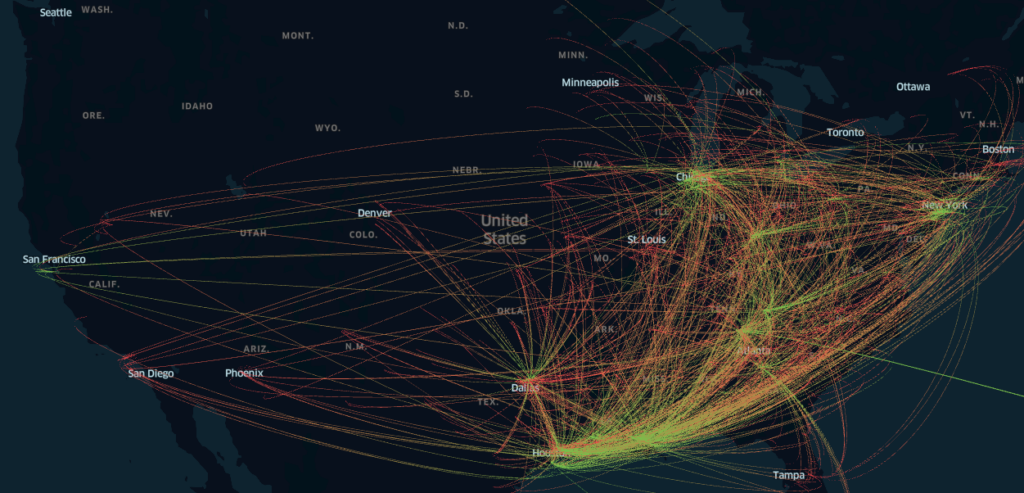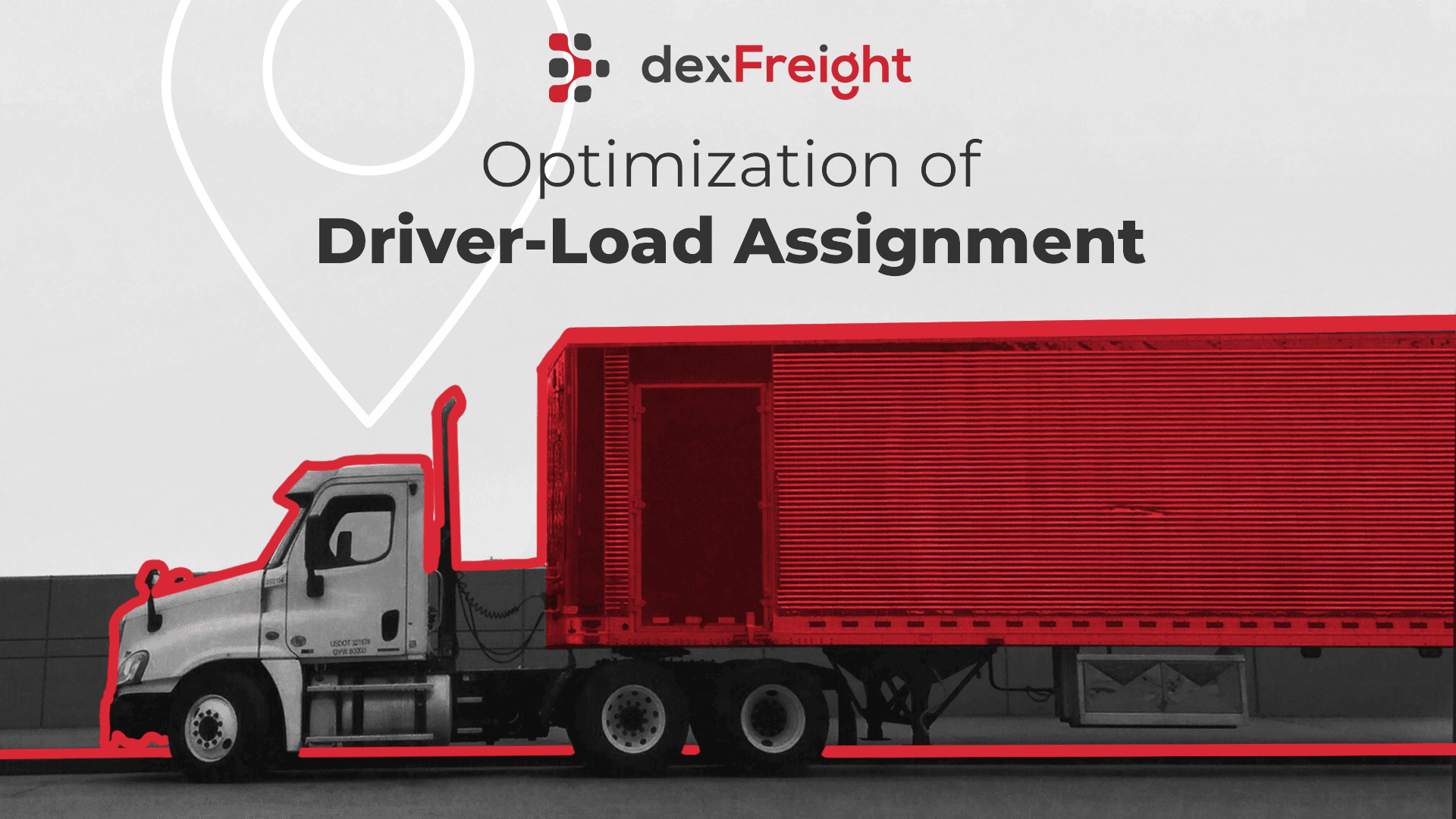Developing a prototype that could save 20% in operational costs for a trucking company
Summary
In 2022, we had the opportunity to develop an optimization algorithm (prototype) for a trucking company, to improve load-driver assignment. The prototype demonstrated it could optimize this operation by reducing deadhead miles by ~20% and non-revenue hours of drivers by ~40%.
Assigning Loads Dynamically to Drivers is Not a Trivial Problem
We were approached by a large US-based trucking company (with ~ 400 trucks fleet, ~350 drivers) with the following questions:
- Can we improve the assignment of loads to the current roster of drivers? Meaning, how to decide which drivers (they have several offices in the country) to assign which set of loads and be able to reduce deadhead miles?
- Can we accept more shipments from customers with minimal addition of drivers/trucks?
- Can we reduce driver turnover by ensuring they are home for the weekend (for long distances) and every day for regional trips?
- Can we provide freight planners with better tools to create load assignment plans by looking at the holistic set of shipments and driver states, rather than first-in, first-out type assignment?
Note: Due to confidentiality reasons, the company’s name can not be revealed. However, we received approval to release this blog and use Figure 1 below.
Current State of Load Assignment at the Company
The trucking company:
- Transports ~ 5000 shipments per month, clocking mileage of ~3 million miles per month – 1.8 million miles loaded, and the rest are deadhead. Average one-way distance = 370 miles, and deadhead miles = 270 miles.
- The company’s drivers are domiciled in several cities across multiple states.
- The company employs about 10 freight planners located at different offices.
- The company currently assigns shipments to drivers based on the proximity of shipments origin to the driver’s domicile location. The freight planners also assign loads to the drivers in a first in, first out (FIFO) for drivers they are familiar with and the loads assigned to that particular office.
The company does not have a system/application by which all freight planners can collectively optimize trips assigned to the company. Freight planners collaborate with each other via phones, and emails, among others.
The image below shows the actual origin – destination of runs during the first quarter of 2022.

Key Performance Indicators
In order to compare the modeled results versus actuals, we used two key performance indicators (KPIs):
- Deadhead miles % = (TotalMiles – LoadedMiles)/ TotalMiles
- Non-revenue hours % = (TotalDriverHours – DutyHours)/TotalDriverHours
These KPIs were also selected because of the availability of appropriate fields in the data provided to us by the company.
Key Objectives of the Prototype We Built
We built the prototype with the following two objectives:
- Verify if using an optimization algorithm (with spatial search) can improve the KPIs of a batch of loads (for a whole week) by comparing them against the historical data.
- Compare load assignments for a set of individual drivers done by the freight planners to that created by the prototype.
In order to accomplish these objectives, we developed a finite state machine (FSM) that stores the state of the load assignments to drivers at each time step, and changes the state as new information about loads and driver’s destination information from the previous trip becomes available. To select a particular set of loads and reduce deadhead miles, we used progressive geospatial search algorithm with the capability to form trip chains.
Use of Finite State Machines and Progressive Geospatial Search
We applied the concept of Finite State Machine (FSM) to this problem, in which the current state represents a specific set of loads assigned to drivers at any given time. As new shipments and information about drivers enter the current state, a new state is created. When there is an input to the machine, the machine’s state changes in that the next state depends only on the current state and the input. In other words, the new state depends on the old state and the input.
Note: We will provide details of how we used FSM in a future blog post.
The algorithm we developed has a multiprocessing and management unit to handle different queries for tours at the same time, and implements a selection of loads to generate a curated list of trips based on the constraints of the drivers. Therefore, multiple load assignments were done at the same time in batches as new shipment requests came in. We used algorithms for the selection of suitable shipment deliveries using a geospatial search algorithm based on Euclidean distance calculations. The prototype also took into consideration the following inputs in the search process:
- List of shipments to be assigned
- Hours of services (HOS)
- Truck availability
- User preferences (Equipment type, Return Date, etc.)
- Trip type (up to three stops)
Results Showed Significant KPI Improvement
The results from the analysis showed a significant improvement of the two KPIs – ~ 20% decrease in dead head miles and ~ 40% decrease in non-revenue hours. There were also improvements in variation of deadhead % and non-revenue hours by trips without sacrificing the number of drivers used. That means the model did a better job of assigning loads to drivers based on their current location, origin-destination of the load, and pickup/delivery dates.
Our Recommendation to the Company
We recommended to the trucking company that the freight planners could use a robust optimization model like the one we developed in the following ways:
- Improve Tactical Operations (daily grind)
- Allows freight planners to perform any post-assignment evaluation using KPIs of what they could have done to make things better. The trucking company in question pointed out that they didn’t conduct such analysis and would be valuable to do so, which we agree.
- Freight planners can perform load assignments from a wider angle (i.e., include many hubs, load types, office locations) instead of doing so only from their own location.
- Improve Strategic Planning (short and medium-term look ahead)
- Modify load assignment strategies periodically to meet target KPIs.
- Optimization models can be fed into “what-if” scenarios to estimate KPIs due to strategic decisions and decide whether to execute the decision. One example of such a scenario is the decision to buy/lease more trucks or hire more drivers to process more loads.
There is no one-size-fits-all solution here because every trucking company is different, and their needs change constantly. Optimization models must be calibrated frequently with the actual observations from the freight planners. Hence, the implementation of models is an evolving and continuous process that requires a dedicated resource behind it. The good news is that given the size of savings that can be realized by the trucking company, we believe the benefit/cost of this tool is in multiples and can be realized in months instead of years.
Conclusion
The use of complex analytics to improve driver utilization and optimization is nothing new. Analytics and machine learning algorithms do one thing well, and that is searching for thousands of alternative solutions many times a second, something humans cannot do. Ultimately, drivers/supervisors/fleet managers must decide which driver delivers which shipment. Hence, a tool like the one we developed provides freight managers and dispatchers with enhanced capabilities to make more effective decisions about assigning loads to the drivers.

CIO and Co-founder at dexFreight

Data Analytics Engineer at dexFreight
About dexFreight
dexFreight is a logistics market network with FinTech capabilities, for freight companies to handle shipments from booking to payment in one place using smart contracts. dexFreight connects carriers, freight brokers, shippers, and other actors of the supply chain through an open logistics network, built on decentralized protocols. For information, visit www.dexfreight.io


